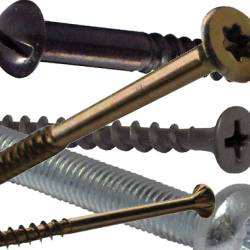What Is The Difference Between Wood Screws And Machine Screws?

When you are planning a joining application it can be daunting to look at the many different types of screws available and trying to work out what you need to use. Some people might think that a screw is just a screw, but choosing the correct screw is essential because it can not only affect how the materials join together in the first place, but will also influence how strong a joint is and how long it lasts. So choosing the right screw for an application is essential from a health and safety point of view, how easy the application is to carry out and also cost-effectiveness, in other words, how long something lasts and how quickly you might need to replace it.
So to understand the difference between a wood screw and a machine screw, we need to study each screw type and establish what its key purpose is and what features it has.
What is a wood screw?
A wood screw, as you might suspect, is a type of screw that is specifically designed to join two pieces of wood, or a wood-based material such as MDF. There are a number of features of a wood screw that distinguish it from other types of screw:
- Pointed end – A wood screw will have a pointed tip, this sharp end is used to penetrate the wood material and bite into it without splitting the wood and without the need to pre-drill a hole. As a means of creating this pointed end, the shaft of the screw will be tapered.
- Thread – A wood screw will have what is known as a ‘coarse’ thread, which means the thread is wider spaced with a medium depth. Again, this coarse thread is designed to provide a strong grip in the wood. A wood screw won’t be fully threaded, the thread will only run about three quarters up the shaft of the screw and not completely to the head.
- Head – A wood screw normally has either a slotted head or a Phillips head. These will match the types of tools that are typically used in wood applications.
What is a machine screw?
A machine screw is used to join metal components together and provide a firm grip without damaging the metal parts. They are used in machinery and equipment, as well as in electronics and when constructing appliances. Again, there are a number of features of a machine screw which differentiate it from a wood screw, or other types of screw:
- Blunt end – Rather than the pointed end of a wood screw, a machine screw will have a blunt end, this is because it usually drives into a pre-drilled hole.
- Thread – The shaft of a machine screw will be consistent in diameter, rather than the tapered shaft of a wood screw. The thread will be smoother and finer because it typically drives into a threaded hole, rather than having to grip into a material. Finally, the shaft of the screw will be fully threaded.
- Head – There can be a variety of head types for a machine screw, such as a slotted or Phillips, but also a hex or torx head. The head itself can also be flat, rounded, pan or oval in shape.
Machine screws are typically used with a tapped hole and often use a nut to secure the screw and fasten the metal parts together. Machine screws are usually used with metals, but can also be used with some types of plastic, and indeed other hard materials.
Contact MB Direct to discuss the right type of screw for your application
So the key difference between a wood screw and a machine screw is the application that each is used for. A wood screw is used to join two sections of wood together, while a machine screw is usually used to join two sections of metal. As always, it is important that you choose the right tools for fastening these screws, but also that you choose the right size of screw.
Wood screws and machine screws can be supplied in various different sizes and diameters, which vary depending on the type of application. Larger and thicker screws tend to be used in more heavy duty applications, while smaller screws are better for lighter-duty applications. But it is important you get this right, otherwise you could damage your materials, cause an accident or have to re-fasten the materials sooner than you would want to. So contact MB Direct today and our team of experts can advise on the best type and size of screws from our vast range of screws and fixings.